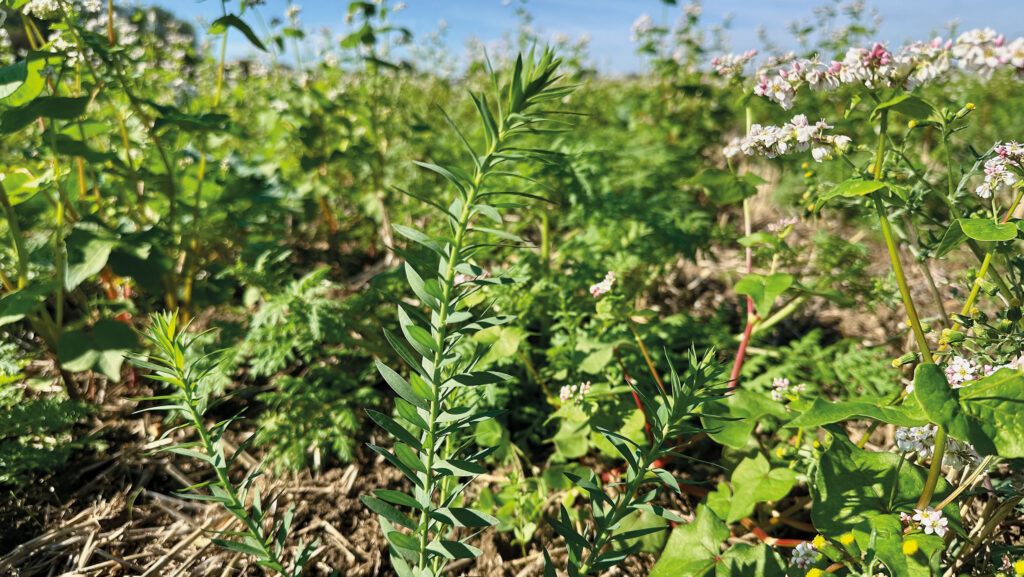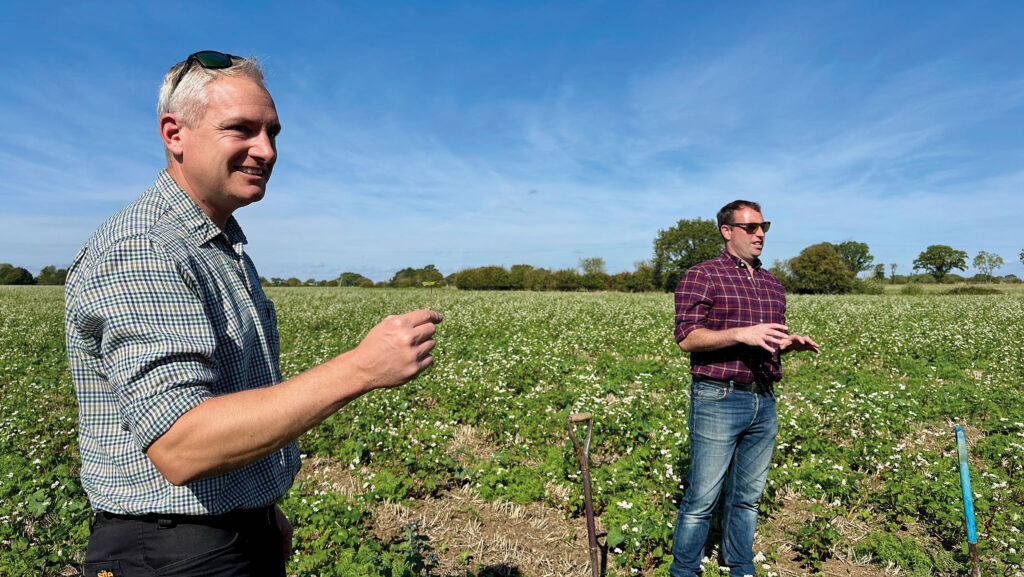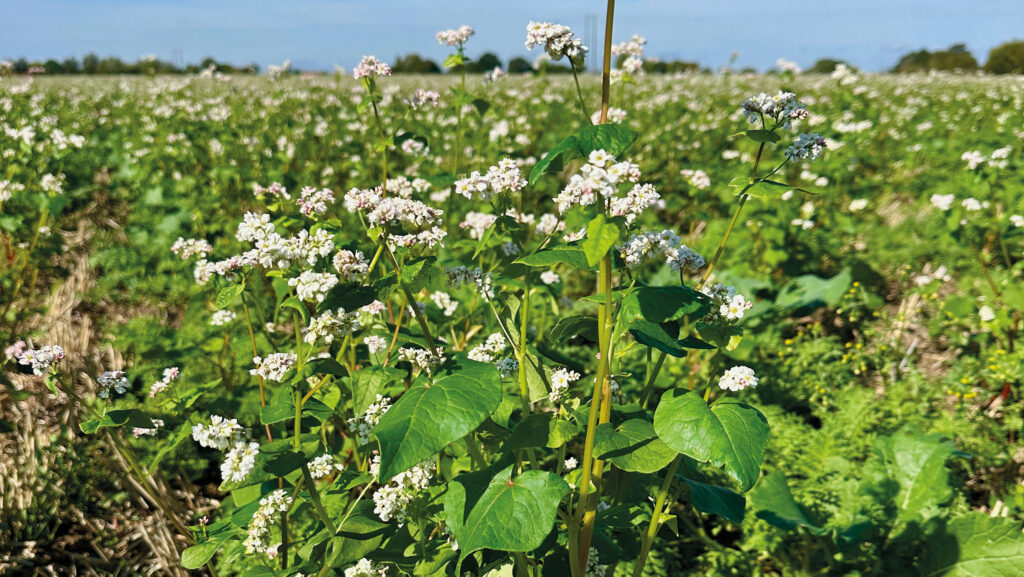Why N cut could be bad for cover crop growth and soil health
 © Mike Abram
© Mike Abram Is the drive to cut applied nitrogen fertiliser inadvertently resulting in poorer cover and catch crop growth to the detriment of soil health?
Evidence from cover crop trials on farms involved with the Climate Neutral farms (ClieNFarms) project led by the Allerton Project in the UK suggests that could be a genuine concern.
See also: Trial shows best break crops and cultivation for wheat profit
Both Richard Ling at Rookery Farm, near Diss in Norfolk, and Tom Jewers at Wood Hall Farm in Rattlesden, Suffolk, have been testing start up technology firm Messium’s claims that it can determine nitrogen concentration in wheat crops using a network of hyperspectral satellites.
But while the results of those trials, plus other growers in the project, are still being analysed, the in-season growth curves used by Messium to determine whether crops are under or over-fertilised suggests that in both Richard and Tom’s trials fields there was potentially a shortage of nitrogen in crops before spring growth had even begun.
What is the ClieNFarms project?
Climate Neutral Farms (ClieNFarms) is an EU Horizon 2020 funded project which supports the transition to climate neutral and climate resilient European farming by scaling systemic, locally relevant solutions at farm level.
In the UK, the project is led by the Allerton Project as the main demonstration farm, with a small number of lead commercial farms, including Richard Ling, Tom Jewers, Ian Matts and Toby Simpson. The aim is to create a carbon credit trading platform for ‘insetting’ quantifiable decarbonisation within the cereal supply chain.
To support that aim, the project has been trialling Landscape Enterprise Networks (LENs) system of buying and selling natural capital outcomes, such as clean water, healthy soil and increased biodiversity.
Dry weather
In Richard’s case, not helped by the dry weather this spring, his wheat crop failed to make the model’s optimal nitrogen status at any point during the season, even after nitrogen applications.
“That means we have to question our approach in the field. Did we have enough N cycling around the system before we reached spring?” Richard asks at a ClieNFarms organised farm walk and discussion at his farm.
There were a number of contributing factors as to why that might be the case on his farm.
These included not taking into account how much nitrogen high-yielding spring malting barley crops that preceded the winter wheat have taken out of the system, as well as a general reduction in recent years in applied N across the farm in response to either high nitrogen fertiliser prices or low-yield potential.

Tom Jewers and Richard Ling © Mike Abram
But he also wondered whether he was giving too much credit to the ability of the overwinter cover crop he grew between the wheat and spring barley to cycle nutrients around the system.
“We know cover and catch crops are working for us, but after a couple of years of success, maybe I gave them too much credit.”
The soil samples and other measurements in the trial – not just those produced by Messium’s hyperspectral imagery – clearly showed there wasn’t enough N in the system from the start.
That conclusion was backed by Tom’s observation from a Yara nitrogen response trial in one of the fields on his farm that was followed by a cover crop.
“It was very apparent that we weren’t applying enough N in most of our wheat that year. We had a lovely cover crop where 300kgN/ha had been applied in the Yara trial, but there was no cover crop growth as well as low N in wheat grain where 200kgN/ha or lower had been applied,” he says.
“There’s a balance and I think we were cutting our N fertiliser too much.”
Trial field
Further proof came in his Messium trial field where N min soil analyses were taken just before harvest.
His trial had four different rates of N applied to tramlines, including one with only 75kgN/ha, which had about one-third of the soil mineral nitrogen compared with the treatments that had more than 225kgN/ha applied.
“It’s no surprise where we put more N on, we have more left,” he says.
But if lower amounts of nitrogen in the soil mean poorer growth from a following overwinter cover crop that could mean growers were “cutting off their nose, to spite our face”, Tom suggests.
“We are also seeing that with straw not breaking down ahead of second wheats if we cut N in first wheat. When we drill the second wheat, we’ve still got a matt of straw because the biology can’t work as there’s too much carbon and not enough nitrogen to break it down,” he explains.

Buckwheat in catch crops © Mike Abram
“As Essex farmer Simon Cowell has said, you can’t build soil or organic matter without sufficient nitrogen.”
A number of possible mitigations were suggested during the discussion at the ClieNFarms event including growing cover or catch crops after pulse crops, where more free nitrogen should be available.
“First wheats after pulses with a catch crop have been my best wheats the past couple of years,” Tom says.
“It might help the whole system,” Richard adds. “But the issue I have with pulse crops is they’re not particularly profitable to grow as a cash crop.”
Beans alternative
As a potential alternative, Richard is trialling a high percentage inclusion of beans in a catch crop mix between spring barley and wheat this season in a tramline trial as part of the ClieNFarms project.
The mix was suggested by Cambridgeshire farmer Toby Simpson, who uses beans in some catch crop mixes depending on place in rotation. In similar trials last season, the mix performed the best in terms of biomass delivery, although it’s only feasible if using home-saved beans, he admits.
“The reason I like them is you get a bit more bang for your buck. If you measure nutrients in cover crop species in a lab, it’s surprising how much is in the beans,” Toby says.
The trial compares bare stubble and three other mixes (see table), including one designed by Northants farmer Ian Matts, which contains mustard and turnip rape.
“The idea is that if we are late planting a catch or cover crop on our heavy soils, at least there’s some mustard that will do something,” he explains.
At Rookery Farm, the four mixes were established on 19 August either by direct-drilling into spring barley stubble with a Horizon or drilled following low disturbance subsoiling using a Grange.
Assessments of cover crop growth will be made by Frontier, which supplied the mixes, via biomass cut downs and satellite imagery. Richard will also take yield measurements from the strips from the following crop of winter wheat, due to drilled in early October.
Rookery Farm catch crop trial mixes |
||
|
Mix name |
Seed rate |
Species mix |
|
Nestle Mix 3 (Ian Matts) |
12kg/ha |
Buckwheat (50%); turnip rape (25%); brown mustard (16.67%); phacelia (8.33%) |
|
Nestle Mix 1 (Toby Simpson) |
95kg/ha |
Beans (87.16%); buckwheat (5.51%); vetch (4.13%); oil radish (1.38%); clover (0.92%); phacelia (0.92%) |
|
Kings 114 Short Summer mix |
16kg/ha |
Buckwheat (50%); linseed (31.25%); phacelia (6.25%); berseem clover (5.75%); crimson clover (5.75%) oil radish (1%) |
|
Rookery Farm mix (Richard Ling) |
15kg/ha |
Vetch (55.77%); buckwheat (21.15%); linseed (11.54%); phacelia (3.85%); berseem clover (3.85%); crimson clover (3.84%) |
|
Source: ClieNFarms |
||

